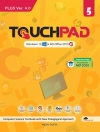The advent of Internet of Things (Io T) has paved the way for sensing the environment and smartly responding. This can be further improved by enabling intelligence to the system with the support of machine learning and deep learning techniques. This book describes learning algorithms that can be applied to Io T-based, real-time applications and improve the utilization of data collected and the overall performance of the system.
Many societal challenges and problems can be resolved using a better amalgamation of Io T and learning algorithms. “Smartness” is the buzzword that is realized only with the help of learning algorithms. In addition, it supports researchers with code snippets that focus on the implementation and performance of learning algorithms on Io T based applications such as healthcare, agriculture, transportation, etc. These snippets include Python packages such as Scipy, Scikit-learn, Theano, Tensor Flow, Keras, Py Torch, and more.
Learning Algorithms for Internet of Things provides you with an easier way to understand the purpose and application of learning algorithms on Io T.
What you’ll Learn
- Supervised algorithms such as Regression and Classification.
- Unsupervised algorithms, like K-means clustering, KNN, hierarchical clustering, principal component analysis, and more.
- Artificial neural networks for Io T (architecture, feedback, feed-forward, unsupervised).
- Convolutional neural networks for Io T (general, Le Net, Alex Net, VGGNet, Goog Le Net, etc.).
- Optimization methods, such as gradient descent, stochastic gradient descent, Adagrad, Ada Delta, and Io T optimization.
Who This Book Is For
Students interested in learning algorithms and their implementations, as well as researchers in Io T looking to extend their work with learning algorithms
Mục lục
Chapter 1: Learning Algorithms for Io T.- Chapter 2: Python Packages for Learning Algorithms.- Chapter 3: Supervised Algorithms.- Chapter 4: Unsupervised Algorithms.- Chapter 5: Reinforcement Algorithms.- Chapter 6: Artificial Neural Networks for Io T.- Chapter 7: Convolutional Neural Networks for Io T.- Chapter 8: LSTM, GAN, and RNN.- Chapter 9: Optimization Methods.
Giới thiệu về tác giả
Dr. G. R. Kanagachidambaresan is a Professor in the Department of CSE, Vel Tech Rangarajan Dr. Sagunthala R&D Institute of Science and Technology. His main research interests includes Io T, Expert systems and Sensors. He has published several reputed articles and undertaken several consultancy activities for leading MNC companies. He has also guest edited several special issue volumes and books at Springer and serves on the editorial review board for peer reviewed journals.
He is currently working on several government-sponsored research projects like ISRO, DBT and DST. He is a TEC committee member in DBT. He is an ASEM-DUO Fellow and has successfully edited several books in EAI Springer. He is currently the Editor-in-Chief for the Next Generation Computer and Communication Engineering Series (Wiley). He received his B.E degree in Electrical and Electronics Engineering from Anna University in 2010 and M.E. Pervasive Computing Technologies in Anna University in 2012. He has completed his Ph.D. in Anna University Chennai in 2017.
Dr. N. Bharathi is an Associate Professor in the Computer Science Engineering Department at SRM Institute of Science and Technology in Chennai, India. Her past experiences are Associate Professor at Saveetha School of Engineering, R&D head at Yalamanchili Manufacturing Private Limited, and Assistant professor in SASTRA deemed university. She has good knowledge to work with Io T and embedded system in addition to computer science engineering concepts.
She was awarded with a Ph.D. degree in Computer Science in 2014 from SASTRA Deemed University, with 19+ years of work experience as an academic and industrial experience as R&D head involved in ARM platform boards with software development in Ubuntu OS. She completed her M. Tech in Advanced computing in SASTRA deemed University and done her M.Tech project internship at Center for High Performance Embedded System (CHi PES), Nanyang Technological University (NTU), Singapore. She was completed her B.E. in computer science engineering in 2002 at Shanmugha College of Engineering (Bharathidasan University). She published many research papers in reputed journals and conferences along with book chapters, advised many B.Tech. and M.Tech. students in various domains of computer science engineering and embedded systems and is currently advising four research scholars.












